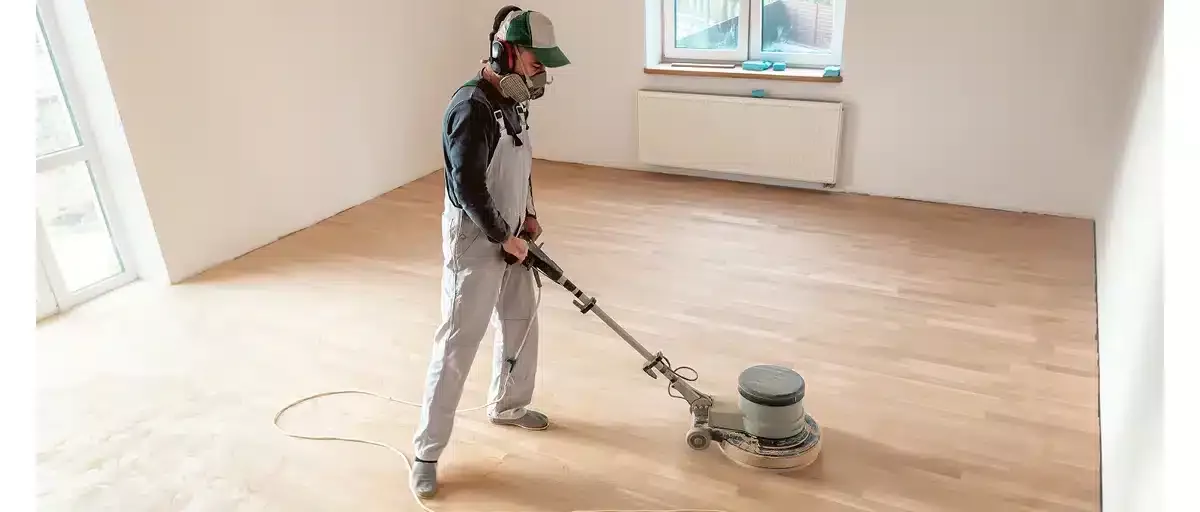London:
Nationwide:
Pressure Washing vs Sanding: Which is More Effective?
Posted on December 8, 2023
Deck Sanding
Comparing Pressure Washing vs Sanding: Discovering the Most Effective Method
When it comes to surface preparation and cleaning, two popular methods often come to the forefront: pressure washing and deck sanding. Both techniques are widely used for a variety of tasks, ranging from home maintenance to industrial projects. However, choosing the right method for your specific needs can be a challenging decision. This blog post aims to shed light on the strengths and weaknesses of both pressure washing and sanding, helping you determine which is more effective for your particular situation.
Pressure washing, known for its ability to quickly clean large surfaces, utilises high-pressure water spray to remove loose paint, mould, grime, dust, mud, and dirt from objects and surfaces like buildings, vehicles, and concrete surfaces. On the other hand, sanding, which involves using abrasive materials to smooth or polish surfaces, is a go-to method for more detailed and precision-driven tasks.
In this comprehensive comparison, we will delve into various aspects of both methods. From the basic principles of how they work to their environmental impact, cost considerations, and safety measures, we aim to provide a thorough understanding of pressure washing and sanding. This will enable you, the reader, to make an informed decision based on efficiency, suitability for different surfaces, and overall effectiveness.
Whether you’re a homeowner considering a DIY project, a professional contractor weighing options for a job, or simply someone curious about these methods, this post is designed to guide you through the intricacies of pressure washing and sanding deck. Join us as we explore the world of surface cleaning and preparation and discover which method emerges as the more effective solution for your needs.
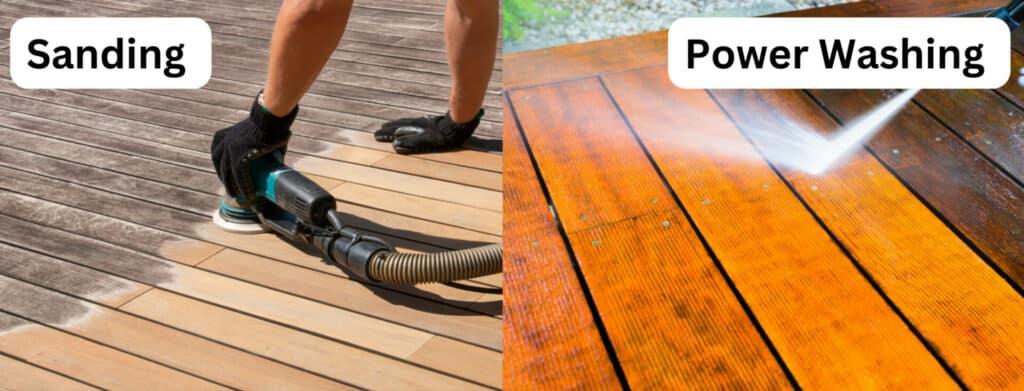
Understanding pressure washing
Pressure washing, also known as power washing, is a cleaning method used in both residential and commercial settings. It involves the use of high-pressure water spray to remove unwanted substances from surfaces and objects such as buildings, vehicles, and concrete roadways. In this section, we will delve into what pressure washing is, its benefits, and its common applications.
What is pressure washing?
Pressure washing harnesses the power of high-pressure water to clean surfaces effectively. The process uses a pressure washer, a machine that pumps water at high velocity. This forceful spray is capable of dislodging and removing dirt, grime, algae, mould, loose paint, and other debris from various surfaces. The intensity of the pressure can be adjusted to suit different types of materials and levels of dirt accumulation, making it a versatile cleaning solution.
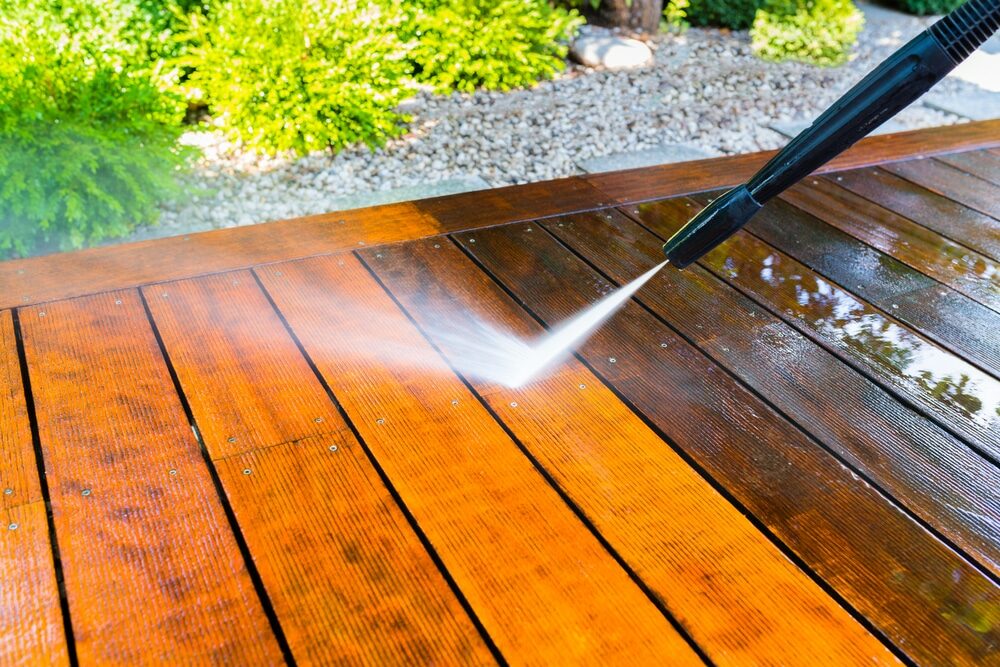
Benefits of pressure washing
- Efficiency and Time-Saving: Pressure washing is significantly faster than manual cleaning methods. It can cover large areas quickly, reducing the time and effort required to clean surfaces.
- Deep Cleaning: The high-pressure water can reach into nooks and crannies, providing a deeper clean than traditional methods. It is especially effective at removing stubborn stains, mould, and other tough-to-clean substances.
- Versatility: Pressure washing can be used on a variety of surfaces, including concrete, brick, wood, and even certain types of siding. This makes it a go-to solution for a wide range of cleaning needs.
- Eco-Friendly Options: When used without harsh chemicals, pressure washing can be an environmentally friendly cleaning method. The sheer force of water is often enough to clean effectively, reducing the need for chemical detergents.
Common Applications
- Home Maintenance: Cleaning driveways, sidewalks, decks, patios, siding, and fencing.
- Commercial Use: Used in cleaning buildings, parking lots, and public spaces.
- Industrial Cleaning: Effective for machinery, large equipment, and industrial facilities.
- Vehicle Cleaning: Ideal for washing cars, trucks, boats, and trailers.
Exploring Sanding
Deck Sanding is a widely used technique in both DIY projects and professional settings, involving the smoothing, polishing, or cleaning of surfaces by abrasion with sandpaper. Sanding is crucial for various tasks, from woodworking to restoration. In this section, we explore the concept of sanding, its benefits, and its common applications.
What is sanding?
Deck Sanding involves using abrasive materials, such as sandpaper or sanding discs, to remove the upper layers of a material, typically for smoothing or cleaning the surface. The abrasive surface of sandpaper is made from various materials, including aluminium oxide or silicon carbide, and comes in different grit sizes to accommodate various levels of abrasion needs. By moving the sandpaper across the surface, either manually or with a power tool, the top layer of the material is worn away, revealing a cleaner or smoother surface beneath.
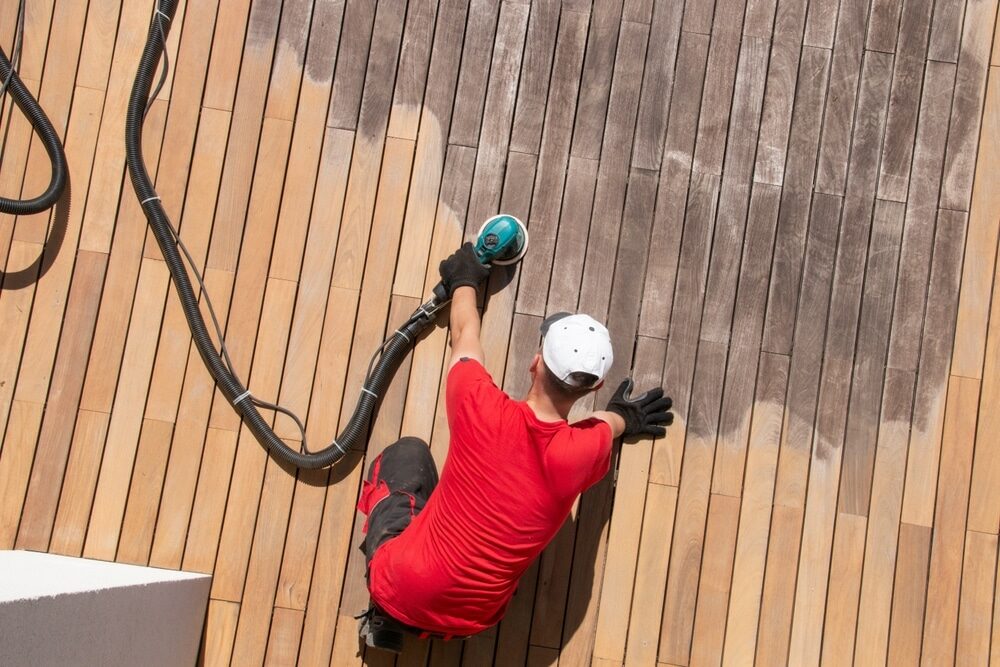
Benefits of Sanding
- Precision and Control: Sanding allows for a high level of control and precision, making it ideal for detailed work or surfaces that require a smooth finish.
- Versatility in Applications: It can be used on a variety of materials, including wood, metal, and plastic. Different types of sandpaper and sanding tools can be chosen based on the specific requirements of the project.
- Preparation for Finishing: Sanding is often a necessary step before painting, staining, or sealing surfaces, as it creates a smooth base that enhances the final appearance and adherence of the finish.
- Surface Restoration: It is effective in removing old paint, varnish, or rust, making it invaluable in restoration projects.
Common Applications
- Woodworking: preparing wood surfaces for painting or staining, shaping, and smoothing wood pieces.
- Metal Work: Removing rust and preparing metal surfaces for painting.
- Auto Body Work: Smoothing car surfaces before painting.
- Furniture Restoration: Stripping old paint or varnish from furniture and refinishing it.
- Drywall Finishing: Smoothing drywall joints and edges.
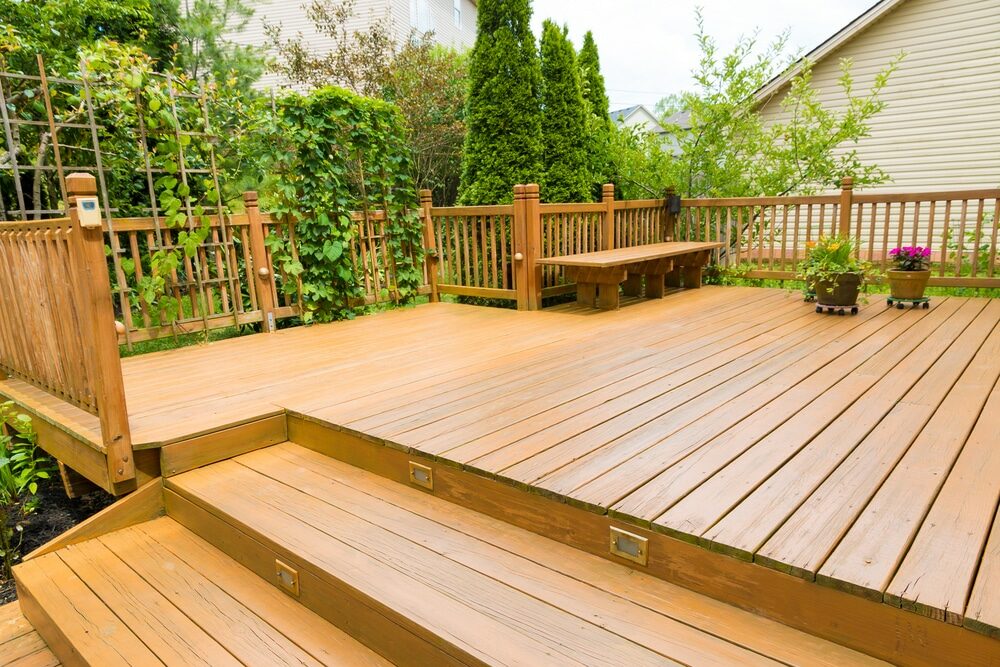
Comparative Analysis: Pressure Washing vs. Sanding
Having explored the basics of pressure washing and Deck sanding, it’s time to dive into a comparative analysis of these two methods. This section will examine their efficiency, suitability for various surfaces, time and labour considerations, and scenarios where one might be preferred over the other.
Efficiency in Different Scenarios
- Pressure washing is ideal for large exterior surfaces like driveways, siding, and decks. It’s highly efficient for removing loose paint, mould, grime, and dirt quickly over large areas. Not suitable for delicate surfaces.
- Sanding: best for small-scale, detailed tasks or when a smooth finish is required. Essential in preparation for painting or staining, especially on wood and metal surfaces. Time-consuming for large areas.
Suitability for Various Surfaces
- Pressure washing is effective on hard, durable surfaces such as concrete, brick, and stone. Can be used on softer surfaces like wood, but with caution to avoid damage.
- Sanding is versatile for a variety of materials, including wood, metal, and plastic. Ideal for surfaces that require a smooth, polished finish. Not suitable for very rough or uneven surfaces.
Time and labour considerations
- Pressure washing is significantly faster and less labour-intensive for cleaning large areas. It requires setup and handling of equipment but reduces manual labour overall.
- Sanding is more time-consuming and labour-intensive, especially for larger projects. Offers more control and precision, which is crucial for detailed work.
Scenarios Where Each Method Excels
- Pressure Washing:
- Cleaning large exterior walls, driveways, and sidewalks.
- Preparing a house for exterior painting by quickly removing loose paint and dirt.
- Cleaning commercial and industrial spaces like parking lots and equipment.
- Sanding:
- Preparing wooden furniture or surfaces for staining or painting.
- Detailed restoration work, like removing rust from metal or old paint from intricate woodwork,.
- Auto body work where a smooth finish is critical.
Environmental Impact: Pressure Washing vs. Sanding
An important aspect of choosing between pressure washing and Deck sanding is understanding their respective environmental impacts. Both methods have different implications for the environment, and being aware of these can guide you in making a more sustainable choice.
Ecological Footprint of Pressure Washing
- Water Usage: Pressure washing relies heavily on water. The amount of water used can be significant, especially for large projects. This can be a concern in areas where water conservation is essential.
- Chemicals and Runoff: When combined with chemical cleaners, pressure washing can lead to harmful runoff. These chemicals can enter waterways, affecting aquatic life and water quality. Using eco-friendly or biodegradable cleaning agents can mitigate this issue.
- Noise Pollution: Pressure washers generate noise, which can be a factor in residential areas or noise-sensitive environments.
- Energy Consumption: Pressure washers require electricity or gas to operate, contributing to energy consumption and, depending on the energy source, greenhouse gas emissions.
Ecological Footprint of Sanding
- Dust and Particulates: Sanding generates dust, which can be harmful to both the environment and human health if not properly managed. Using sanders with dust collection systems and wearing appropriate personal protective equipment is crucial.
- Chemical Strippers and Solvents: When sanding is used for removing paint or varnish, it often goes hand-in-hand with chemical strippers, which can be toxic and harmful to the environment if not used and disposed of correctly.
- Resource Consumption: The production and disposal of sandpaper and other abrasive materials contribute to resource consumption and waste.
- Energy Usage in Power Sanding: Power sanders, like pressure washers, require electricity or batteries, contributing to energy use and potential emissions.
Balancing environmental considerations
- Water Conservation: If conserving water is a priority, sanding might be the preferable option, especially for smaller, more detailed projects.
- Managing Chemicals and Waste: Using environmentally friendly products and proper waste disposal methods are essential, regardless of the method chosen.
- Minimising Airborne Particulates: When sanding, especially indoors, good ventilation and dust collection systems are vital for reducing environmental and health impacts.
- Energy-Efficient Practices: Opting for energy-efficient machines or manual methods where feasible can help reduce the environmental impact.
Both pressure washing and Deck Sanding have environmental impacts that should be considered. By understanding these impacts and taking steps to mitigate them, such as using eco-friendly products and efficient equipment, you can make more environmentally responsible choices in your projects.
Cost Comparison: Pressure Washing vs. Sanding
When deciding between pressure washing and sanding for a project, cost is a significant factor. This section provides a breakdown of the expenses associated with each method, covering equipment, materials, and long-term financial implications.
Equipment and material costs
Pressure Washing
- Pressure Washer Purchase or Rental: Buying a pressure washer can be a considerable investment, with prices varying based on size and power. Rentals are a cost-effective option for one-time or infrequent use.
- Water Usage: The cost of water usage should be factored in, especially for large projects or in areas with higher water rates.
- Cleaning Solutions: If specific cleaning agents are required, this will add to the cost. Eco-friendly options might be more expensive but are better for the environment.

Sanding
- Sanding Tools: The cost can vary widely, from inexpensive manual sandpaper to more costly power sanders. For occasional use, manual tools may suffice, but for frequent or large-scale projects, investing in a power sander might be more economical in the long run.
- Abrasive Materials: Sandpaper and other abrasive materials need regular replacement, adding to the cost, especially for larger projects.
- Safety Equipment: Proper safety gear, like masks and goggles, is necessary, especially when working with power sanders or toxic materials.

Long-Term Financial Implications
Pressure Washing
- Maintenance and Repairs: Owning a pressure washer involves maintenance and potential repair costs. Regular use can lead to wear and tear, necessitating part replacement or professional servicing.
Sanding
- Tool Longevity and Maintenance: Power sanders and other tools require maintenance. The longevity of these tools can offset initial costs if they are maintained properly.
Cost-Effectiveness for Different Projects
- Pressure washing is more cost-effective for large outdoor projects due to its speed and efficiency. Rental options can further reduce costs for occasional use.
- Sanding: For smaller, detail-oriented tasks or where a smooth finish is required, sanding is more cost-effective. Manual sanding tools are inexpensive and suitable for infrequent, small-scale projects.
Safety and Health Considerations: Pressure Washing vs. Sanding
When choosing between pressure washing and sanding, it’s crucial to consider the safety and health implications of each method. Both entail specific risks and require appropriate safety measures to ensure the well-being of the user and others in the vicinity.
Safety Measures for Pressure Washing
- High-Pressure Hazards: The high pressure of the water jet can cause injuries. It’s essential to never point the pressure washer at yourself or others and to wear protective clothing, including gloves and eye protection.
- Slippery Surfaces: The process can make surfaces slippery. Caution is needed to prevent slips and falls.
- Electrical Safety: If using an electric pressure washer, be aware of electrical safety, especially around water. Use a ground-fault circuit interrupter (GFCI) for added protection.
- Chemical Use: When using chemical cleaners, proper ventilation, protective clothing, and eye protection are necessary to avoid inhalation or skin contact.
Safety Measures in Sanding
- Dust Inhalation: Sanding produces dust, which can be harmful if inhaled. Always use a dust mask or respirator, especially when sanding materials like old paint that might contain lead or other harmful substances.
- Eye Protection: Dust and debris can cause eye injuries. Safety goggles are a must to protect your eyes.
- Hearing Protection: If using power sanding tools, they can be loud enough to warrant the use of ear protection.
- Skin Protection: Long-term exposure to vibration from power sanders can lead to issues like hand-arm vibration syndrome. Wearing gloves can help mitigate this risk.
Health Impacts
- Pressure washing can lead to fatigue due to the handling of heavy equipment. The noise produced by pressure washers can also contribute to hearing loss over time if proper ear protection is not used.
- Sanding: Prolonged exposure to dust can lead to respiratory issues. It’s crucial to ensure good ventilation and to use a dust collection system if possible.
In both methods, understanding and adhering to safety protocols are essential. While pressure washing poses risks associated with high pressure and slip hazards, sanding’s primary concerns are dust inhalation and the impact of vibration. By taking appropriate precautions, such as using protective gear and being mindful of the operational risks, these methods can be used safely and effectively.

Conclusion: Pressure Washing vs. Sanding: Weighing the Options
As we conclude this exploration of pressure washing versus Deck sanding, it’s clear that both methods offer unique advantages and are suited for different types of tasks. The choice between these two depends on various factors, including the nature of the project, environmental impact, cost, and safety considerations. Let’s summarise the key points:
Summarising Key Points
- Pressure washing is ideal for large-scale, outdoor cleaning tasks. It’s efficient, time-saving, and effective for removing dirt, grime, and loose paint from hard surfaces. However, it requires caution due to the high pressure and potential chemical runoff.
- Sanding is perfect for detailed work and surface preparation, especially where a smooth finish is required. It offers precision and control but can be time-consuming and labour-intensive for larger projects. Dust management and safety are key concerns.
Personal Recommendations
- Assess the Project Requirements: For large, outdoor surfaces or quick cleaning jobs, pressure washing is more effective. For detailed work, restoration, or preparing surfaces for painting or staining, sanding is preferable.
- Consider Environmental Impact: Use eco-friendly options and proper waste disposal methods to minimise the environmental footprint, regardless of the method chosen.
- Prioritise Safety: Employ appropriate safety measures, including protective gear and adherence to safety protocols, to prevent accidents and health risks.
- Evaluate Cost Implications: Choose the method that aligns with your budget, considering both immediate and long-term costs, including equipment, materials, and maintenance.
Both pressure washing and sanding have their place in maintenance and restoration work. By understanding their strengths, limitations, and appropriate applications, you can make an informed decision that best suits your specific needs, ensuring effective and safe project completion.

Sanding
We provide virtually dust-free sanding with our continuous belt machinery with mobile extraction units, giving you a safer environment for your family.
Oiling
This organic finish not only adds beauty to your home but also has exceptional water-repellent characteristics, making it easier to clean and maintain.
Waxing
This natural floor finish offers the softest and most mellow appearance – and leaves your floor able to breath.
Buffing
Using soft buffing machines (and hand-polishing where required) will bring a wonderful sheen to your newly-finished floor.
Repairs
We offer a full assessment of your wooden floors to determine what repairs are needed to provide the perfect working surface for the later stages of sanding, staining and sealing.
Restoration
We offer a comprehensive restoration process designed to address floors that are improperly fitted or damaged over time through wear and tear.
Request a fixed price quote for your wood floor restoration now
Simply enter your postcode below to get started.
Services
Wood Floor Sanding Wood Floor Restoration Wood Floor Scratch Repair Squeaky Wood Floor Repair Parquet Floor Sanding Parquet Floor Restoration Commercial Floor Sanding Church Floor Sanding Community Centre Floor Sanding School Floor Sanding Gap Filling Gap Filling with ResinCopyright © Mr Sander®
Privacy & Cookies Terms & Conditions Complaints Procedure Cancellation Rights Sitemap